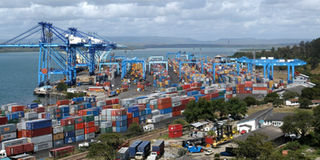Shortage of containers hampers Uganda’s trade

Containers stacked at Mombasa port. According to a survey by Kenya Ports Authority, South Sudan is emerging as a new key transit route. FILE PHOTO
What you need to know:
Uganda’s exports realised a marginal decline, posting 346,193 tonnes in 2012 against 347,314 tonnes handled in 2011.
Kampala
The scarcity of 20-foot-cargo containers in the country is hurting Ugandan exports because they are the most favoured by the exporters.
Maersk Line, the leading global freight and Logistics Company, attributes the shortage of the containers to the new South Sudan market where Sudanese nationals are accused of retaining the containers for use in accommodation and shops. There are also concerns about the demand of the containers in the Middle East, Asia and Europe the leading source of imports for the East African Community.
New destination
In an interview yesterday, Mr Steve Felder, the Maersk line managing director of East Africa, observed that despite being landlocked coupled with the recent South Sudan independence, Uganda is now a leading destination for containerised cargo from Asia and Europe. “European economies are no longer growing and we see Africa becoming an interesting market particularly East Africa and South Sudan where they need almost everything from roads, schools and hospitals, among others,” he said.
According to Ms Eunice Karugonjo, the Maersk line manager Uganda, despite the growing number of containers, one of the major challenges the logistics company is facing, is the shortage of 20-foot-containers. “We have stopped sending them to Sudan because whenever we send them there with cargo, they never return. We have resorted to sending the goods there as loose cargo, and yet even the ones we send to Mombasa with sesame, coffee, and cotton, do not return,” she told this newspaper.
She advised Ugandan traders to start thinking of maximising the use of the logistics and freight services as the country embarks on the oil and gas production journey by positioning themselves into the sector. This, she says, is necessary as most of the in-puts that will the required to support the industry will have to be imported.
“We are looking at how to tap into the oil and gas sector by preparing now. Uganda is exporting cocoa, cotton, coffee timber, hides and skins, yet most of the imports we see going to South Sudan are biscuits, beverages sugar and concentrates as well as building materials. We think it is time for Ugandan traders to start positioning themselves to tap into the oil revenues,” she said.




